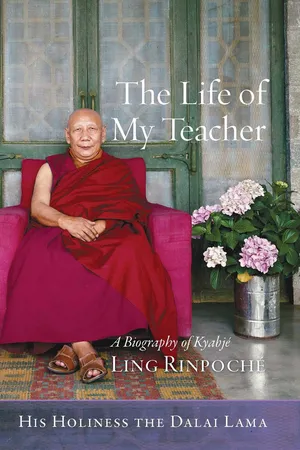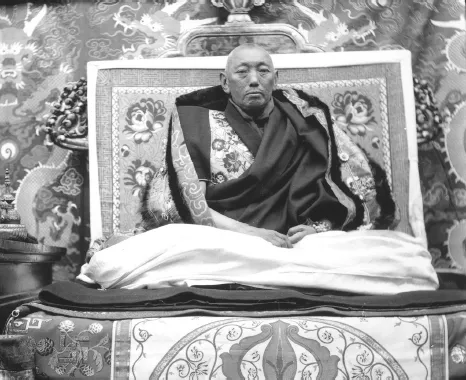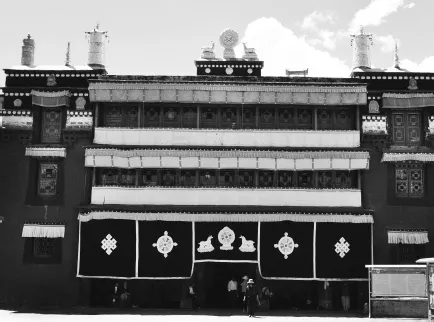![]()
PART 1
Childhood and Early Monastic Life, 1903–24
![]()
THIS LAND surrounded by a wall of cooling snow mountains is divided up into Tibet and Greater Tibet. In earlier times, during the reigns of the three great ancestral Dharma kings,18 Tibet was also divided into the four regions of Ütsang.19 Of these four, he was born in the central region of Uru. His actual birthplace was Kyishö, a place replete with all the qualities of the ten virtues, otherwise known as Yaphu, famed as the abode of Cakrasaṃvara and consort and a day’s journey northwest of the capital, Lhasa. There the land is shaped like a triangular dharmodaya.20 The mountains in the distance resemble a heap of jewels. On the sides of the surrounding hills are shapes of vowels and consonants. Sitting amid the foreground hills, which resemble draped silk, is the hermitage of Ratsa. Of its many sacred objects, the main one is a statue of Vajrayoginī, the meditation deity of the great Paṇchen Nāropa, which many times has given spoken replies to questions asked of it, thereby endowing it with the powerful blessing of “liberation through seeing.” There is a small and delightful shortcut known as the Ḍākinī hill path between his birth village of Karbok and Ratsa hermitage.
On the mountains in the distance can be seen a stack of rocks known as the Palace of Cakrasaṃvara (plate 5), and because of this feature the name of this region is Yap.21 This means that a constant stream of devout pilgrims—ordained and lay, men and women—come from Lhasa and elsewhere to make offerings. Moreover, there are very many accounts of the arising of realization and experiences in several great beings that have practiced in this place.
It is difficult for an ordinary being like me to gauge precisely the intention of this great being. However, were I to speculate why he took birth in that place, I would say that in the eyes of his ordinary disciples, this root guru of ours had achieved advanced spiritual stages by relying on the vajra paths of Śrī Cakrasaṃvara with consort and Vajrabhairava. The master was now instructing his followers that should they also wish to quickly gain the stage of union endowed with its seven features,22 it is proper to rely upon such meditation deities. Also, he would be able to care for the people of this area through their seeing, hearing, remembering, and coming into contact with him.
I have not found a reliable source from whom I can enquire about the family background of our master’s mother and father. However, he was born into a very poor household in Karbok, subjects of the private Yuthok Drachen estate that was the household of the Tenth Dalai Lama. His father was Kunga Tsering and his mother Sönam Dekyi. Great beings take birth in royal families such as the Shing Sala family, as well as in rich, poor, and moderately well-off households, for special reasons. I think the reasons that this holy being deliberately took birth in a poor family was firstly to care for two beings who had fostered roots of virtue over many lifetimes and who had prayed to be the parents of this great and holy being. Secondly, he was teaching that preserving and spreading the teachings of the Buddha do not depend upon family lineage but upon the qualities of study, contemplation, and meditation. As the Buddha himself said, “In my doctrine, lineage and family are not the main considerations. Dharma practice is.”
Our master was born in the year 1903,23 or in the water-rabbit year of the fifteenth sixty-year cycle, in the very early morning of the sixth day of the eleventh month. It is said that he emerged still inside the amniotic sac and his mother hesitated, not knowing what to do. At that moment he cried out “A-ye!” and with the movement of his arms, became free of the amniotic membrane.
His predecessor, Venerable Losang Lungtok Tenzin Trinlé, exhibited passing away on the eighth day of the eighth month of the water-tiger year, when he was forty-seven years old (1902). From one point of view it appears as if he did not complete a full life. However, the reality is that he returned as the display of a supreme incarnation to be the guide for the doctrine and for living beings such as myself. At a time when the sun of the doctrine of the Buddha was shining brightly in the Dharma land of Tibet, he listened and received all the initiations, transmissions, core instructions, and so on in the presence of many learned and adept masters. He became the master of the doctrine of scripture and insight, thereby sustaining the teachings of the Buddha Śākyamuni in general, and specifically those of the second Buddha, Tsongkhapa Losang Drakpa. His incarnation was therefore timely. In particular, from the time I learned how to read and write, he bestowed upon me, who is the fourteenth in the lineage of the Holder of the White Lotus,24 the complete teachings of sutra and tantra in the manner of a pot being filled to the brim. In particular, after the doctrine had been reduced almost to a point where its name had vanished in the Dharma land of Tibet, in keeping with the prophecy of the Buddha that the doctrine would go from north to north and then would spread again in the central region, the master clearly took on the form of regent of the second Buddha Tsongkhapa in the noble land of India, and he ensured that the doctrine shone like the sun. Without a doubt it is for these reasons that he took birth at such time.
This glorious lama was the eldest son of the parents mentioned above. They also had a son Öser and a daughter Bakdro. While this great being was still in his mother’s womb, his father traveled to the Lhasa district to sell dung, and there his load-carrying mules died. I think that this and other troubles that occurred were the work of Makaradhvaja25 and his cohorts, who set out to obstruct the extensive activities that this great being would go on to perform for the doctrine of the second Buddha and others. As the saying goes, “When the Dharma is profound, the hindrances will be profound.” I am not clear about the time and circumstances of his father’s passing, but Rinpoché told those around him that he had never met his father.
There can be no doubt that, even at such a tender age, the nature of this great being far surpassed that of ordinary beings. However, as to the details of the master’s early childhood, I have found no reliable source, so I cannot write more about it here.
The Thirteenth Dalai Lama on his throne at the Potala Palace
![]()
5 | Searching for the Reincarnation |
AFTER RINPOCHE’S PREDECESSOR had passed away, Jampa Losang, who was the predecessor’s nephew and attendant, approached the Great Thirteenth for a divination and the two oracles of Nechung and Gadong for a prophecy concerning his reincarnation. The replies came back: “Not far, directly northwest of the temple of the Kalsang Palace in the Norbulingka . . .”26 Also:
In the south, as considered from
the time of the predecessor,
will be found the unmistaken reincarnation,
the enlightened body, speech, and mind as one.
The great Dharma protector of Gadong also declared that the place would be Yap. Thus it was clear that this would be the birthplace, and any doubt about the area in which to conduct the search for the incarnation was resolved. Yaphu was northwest of the Norbulingka Kalsang Palace and south of Phenpo Rakma, the birthplace of his predecessor. It was between the two.
When making a detailed search for children with special signs born in the small settlement of Yaphu, three were identified. They were Losang Gyatso, son of Jangkha Lhopa, who was an official in the general revenue office of Drepung Monastery; Sönam Wangden, a child from Karbok; and Yeshé Namdak, the son of a tenant of Phukpoché estate. A request for divination was made to the Gadong protector asking for identification of the correct incarnation from these three. Without saying clearly which child this was, the response from the protector was that to resolve this issue, they should go to the lands of China and Mongolia, where the great master Meaningful to Behold27 was visiting. Accordingly, the attendant Jampa Losang and a party set out from Lhasa.
Prior to leaving, Jampa Losang invoked the great Gadong protector through the oracle and requested that, when making this long journey to China and Mongolia for the purposes of identifying the correct incarnation, there be no obstacles and their task be successful. The reply came, “There may be a few hindrances, but as in the past, I the spirit will help you.” In keeping with this prophecy, a few of the servants did not want to make such a long journey. They conspired together, and one night on the northern plains they cut the ropes of the tents, threw stones, and so on. However, not much damage was done, and those servants suspected of being involved were sent back at once. The attendant Jampa Lobsang was someone who believed resolutely in the protector Nechung and consequently had brought with him the little statue of Nechung, which he usually kept in his room. It is said that at this time the small bells that adorned the brocade on the statue began to ring.
Whatever the case, because of the unfailing assistance produced by the four types of activities28 that are performed by the vast ocean of oath-bound protectors, they arrived safely in the Tashi Lhunpo Ling Monastery of Khadro Chingwan Dākhural in Mongolia, where the previous Dalai Lama was staying. They at once made their prostrations and presented to him a detailed account of their search for the precious incarnation. They requested a divination through the vision of his exalted wisdom on who was worthy of being the unmistaken reincarnation from among the three children. In response he placed his seal of approval upon the name of Sönam Wangden, the boy from Karbok, as being the unmistaken incarnation and gave him the name Thupten Lungtok Namgyal Trinlé. The Great Thirteenth also composed a long-life prayer entitled Nectar for the Supreme Granting of All Wishes. In the colophon of this long-life prayer, found in the collected works of the Great Thirteenth, it says, “Although I have not received any entreaty for assistance from the manager of the Ling Labrang in the search for the incarnation, I remember the kindness of my holy tutor and have trust in the divination request made to the Mahārāja.”29 The manager of Ling Labrang at that time was a monk from Dargyé Ling of Lhokha district. There was a child from Lhokha who could have been the incarnation, and he had high hopes that this was indeed the case. It seems that the manager did not pay as much attention to the other candidate children.
As mentioned previously, the birthplace of the previous incarnation was Phenpo Rakma, while the birthplace of this present incarnation is Ratsa. Thus the names of both birthplaces contain the syllable ra. It is said that this illustrates that Rinpoché is a manifestation of Ra Lotsāwa.30
The Great Thirteenth gave careful instructions to the attendant Jampa Losang on the relevant ceremonial duties to be performed around the enthronement. Accordingly, when Rinpoché arrived in Lhasa, he was offered a set of robes and led to Garpa Hermitage (plate 6), where he was enthroned on the high Dharma throne that had been blessed by his previous incarnations. When he was being escorted from his birthplace in Karbok in the early morning, he reached the circumambulation path around the Ramoché temple at the same time that the morning assembly gong was being struck at Gyütö Monastery. According to the senior monks this was clearly an auspicious sign that this great being would later enroll in the glorious Gyütö Monastery, complete his study, contemplation, and meditation within the vast ocean of tantras to rise as a great teacher of tantra endowed with the two sets of ten principles,31 and preserve and spread the teaching of mantra as if vajra-holder Kunga Döndrup32 himself had come again.
Gyütö Monastery’s main temple in Lhasa, also known as Ramoché.
![]()
ALTHOUGH I AM not sure...



